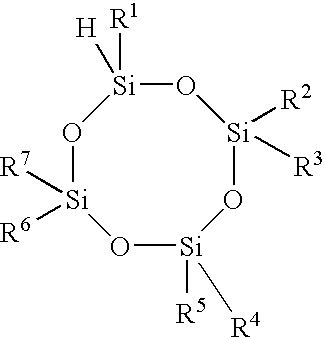Stabilizers to inhibit the polymerization of substituted cyclotetrasiloxane
a technology of stabilizer and cyclotetrasiloxane, which is applied in the direction of organic chemistry, coatings, silicon oxides, etc., can solve the problems of tomcats type siloxane's instability in polymerization, limited acceptance of tomcats type siloxane as a cvd source for semiconductor device manufacturing, and low volatility liquid or gel
- Summary
- Abstract
- Description
- Claims
- Application Information
AI Technical Summary
Benefits of technology
Problems solved by technology
Method used
Image
Examples
example 1
Polymerization Under Vacuum Conditions
Stability of TOMCATS Type Siloxane, With and Without BHT
[0031]Six quartz ampoules with a nominal volume of 80–90 ml were used for this test. These ampoules will be referred to in the present example as 1A, 1B, 1C, 1D, 1E and 1F. These ampoules were prepared by rinsing twice with distilled water, twice with reagent grade acetone, then placed into a drying oven at 175° C. for 16–18 hours. The dry ampoules were removed from the oven and used while still warm. Approximately 5.0 ml of additive free TOMCATS type siloxane was loaded into ampoules 1A, 1B, 1C and 1D. A similar amount of TOMCATS type siloxane containing 150 ppm (by weight) BHT was loaded into ampoules 1E and 1F. Teflon valves were attached to the open end of the ampoules. The end of ampoule 1A was immersed in a liquid nitrogen bath to cause any vaporized TOMCATS type siloxane to condense. The air was evacuated from the headspace of the ampoule by subjecting it to vacuum for 5 minutes. The...
example 2
Sensitivity to Carbon Dioxide
Exposure of TOMCATS Type Siloxane to 0.50 Weight % Carbon Dioxide
[0033]Four quartz ampoules (2A, 2B, 2C and 2D) were cleaned and dried as described in Example 1.Approximately 5.0 g of TOMCATS type siloxane containing no additive was loaded into ampoules 2A and 2B. A similar amount of TOMCATS type siloxane spiked with 150 ppm by weight of BHT was loaded into ampoules 2C and 2D. Each of the 4 Ampoules was equipped with a quartz side-arm extension, capped with a septum. Ampoule 2A was cooled to liquid nitrogen temperature and evacuated to remove the air in the headspace. The ampoule was isolated from the vacuum and 19 sccm of gaseous carbon dioxide was injected via a syringe through the septum cap on the side arm. The ampoule, still under sub-ambient pressure, was sealed using a torch as described in Example 1. The remaining 3 ampoules (2B, 2C and 2D) were prepared and sealed in the same manner. All four sealed ampoules were heated for 24 hours at 90° C. as...
example 3
Sensitivity to Oxygen
Exposure of TOMCATS Type Siloxane to 0.50 Weight % Oxygen
[0034]Four quartz ampoules (3A, 3B, 3C and 3D) were cleaned and dried as described in Example 1.Approximately 5.0 g of TOMCATS type siloxane containing no additive was loaded into ampoules 3A and 3B. A similar amount of TOMCATS type siloxane spiked with 150 ppm by weight of BHT was loaded into ampoules 3C and 3D. Each of the 4 ampoules was equipped with a quartz side-arm extension, capped with a septum. Ampoule 3A was cooled to liquid nitrogen temperature and evacuated to remove the air in the headspace. The ampoule was isolated from the vacuum and 19 sccm of oxygen was injected via a syringe through the septum cap on the side arm. The ampoule, still under sub-ambient pressure, was sealed using a torch as described in Example 1. The remaining 3 ampoules (3B, 3C and 3D) were prepared and sealed in the same manner. All four sealed ampoules were heated for 24 hours at 90° C. as described in Example 1. TOMCATS...
PUM
| Property | Measurement | Unit |
|---|---|---|
| Fraction | aaaaa | aaaaa |
| Fraction | aaaaa | aaaaa |
| Fraction | aaaaa | aaaaa |
Abstract
Description
Claims
Application Information
 Login to View More
Login to View More - R&D
- Intellectual Property
- Life Sciences
- Materials
- Tech Scout
- Unparalleled Data Quality
- Higher Quality Content
- 60% Fewer Hallucinations
Browse by: Latest US Patents, China's latest patents, Technical Efficacy Thesaurus, Application Domain, Technology Topic, Popular Technical Reports.
© 2025 PatSnap. All rights reserved.Legal|Privacy policy|Modern Slavery Act Transparency Statement|Sitemap|About US| Contact US: help@patsnap.com



